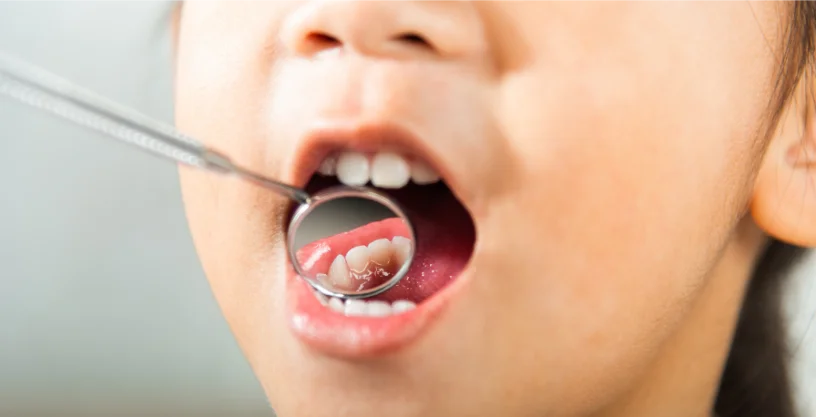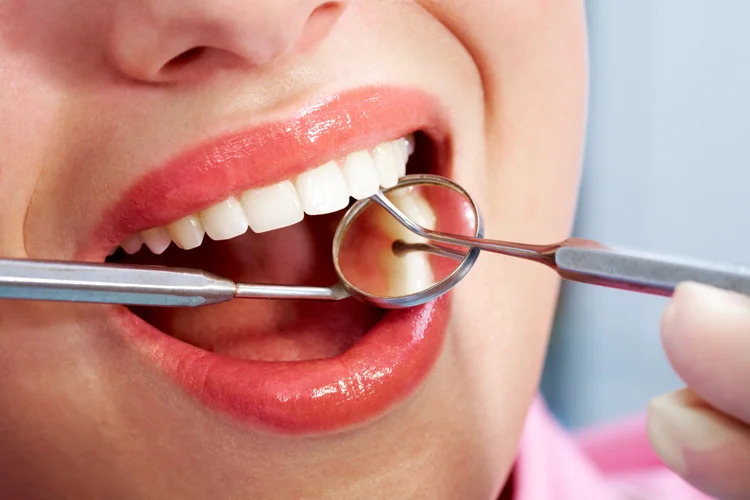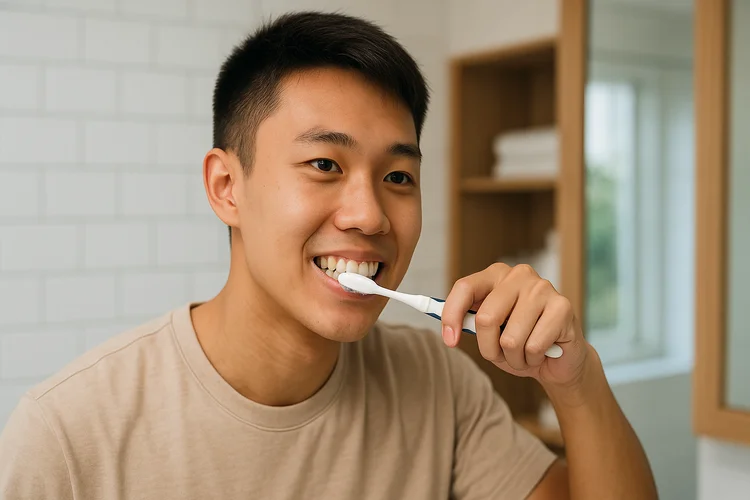Are you curious about how many teeth you have or trying to count them in the
mirror?
Most adults have 32 permanent teeth, while
children usually have 20 primary teeth that gradually fall out
to be replaced by adult teeth.
From baby teeth to wisdom teeth, each stage plays a role in oral function
and overall dental health. Whether you're tracking your child's dental
development or noticing changes in your own teeth, understanding what to
expect can help you make informed choices.
This article explains how many teeth a person typically has at different
ages, reasons why some individuals may have more or fewer teeth, and what
options are available if some teeth are missing.

Primary Teeth: The First Set
Children develop a total of 20 primary teeth, also known as deciduous or baby teeth, which usually begin to erupt at around six months of age. The full set typically includes:
- 8 Incisors – 4 upper and 4 lower front teeth used for biting and cutting food.
- 4 Canines – Two upper and two lower pointed teeth located next to the incisors that help tear food.
- 8 Molars – Located at the back of the mouth, these broader teeth help with chewing and grinding.
By the age of three, most children will have their complete set of primary
(baby) teeth, which play important roles in chewing, speaking, and guiding
the proper development of the permanent teeth that will come in later.
Around age six, these primary teeth typically become loose and fall out as
they are gradually replaced by permanent teeth. If baby teeth are lost too early or retained for too long,
it can impact the spacing and alignment of the adult teeth.

Permanent Teeth in Adulthood
By the late teenage years or early twenties, most people will have a
complete set of 32 permanent teeth, with 16 in the
upper jaw and 16 in the lower jaw.
This adult set follows the same basic structure as the primary teeth but
includes 12 additional molars to support the greater
functional demands of a fully developed jaw. Among these are the 4
third molars, more commonly known as wisdom
teeth.
Wisdom teeth are the last to erupt, usually appearing between the ages of 17
and 25. However, they may not emerge fully or align properly due to limited
space in the jaw. This can lead to issues such as impaction, crowding, or discomfort.

Variations in Tooth Count
Although 32 is the typical number of permanent teeth in adults, not everyone develops or retains this full set. Several factors can lead to variations in tooth count:
- Fewer Teeth (Hypodontia) – A developmental condition in which one or more teeth fail to form.
- Extra Teeth (Hyperdontia) – A rare condition where additional teeth, known as supernumerary teeth, develop beyond the normal count.
- Impacted Teeth – Teeth that remain partially or fully trapped below the gum line, most often involving wisdom teeth.
- Wisdom Tooth Removal – Many adults have their third molars removed due to address or prevent complications, resulting in a functional count of 28 teeth.
- Tooth Loss – Decay, gum disease, or trauma can result in the loss of one or more teeth over time.
WhatsApp Us Now
Replacing Lost or Missing Teeth
When one or more teeth are missing, replacing them is often recommended to restore
oral function, support surrounding teeth, and prevent bone loss in the jaw.
The most suitable treatment
option for replacing a tooth depends on factors such as how many teeth are
missing, the condition of the surrounding tissues, and individual preferences.
Common options include:
| Treatment | Description | Common Use |
|---|---|---|
| Dental Implants |
A titanium post surgically placed in the jawbone to serve as an
artificial tooth root. Supports a crown,
bridge, or denture once integrated with bone.
Long-term stability and helps preserve bone structure. |
Ideal for replacing a single tooth or supporting larger restorations |
| Dental Bridges |
An artificial tooth (or teeth) anchored to adjacent natural teeth or
implants. Fixed in place and designed to span the gap left by missing
teeth.
Restores function and appearance with a non-removable solution. |
Used when one or more teeth in a row are missing |
| Removable Dentures |
Custom-made appliances used to replace multiple missing teeth. Available
as partial or full sets for either arch.
More accessible and cost-effective; newer designs offer improved comfort. |
Suitable for those missing several or all teeth |
Preventing Tooth Loss
Tooth loss often results from preventable issues such as tooth decay, gum
disease, or injury. Preserving your natural teeth into adulthood depends on
consistent oral care and early intervention when problems arise.
Key habits that help prevent tooth loss include:
- Brushing teeth at least twice daily with fluoride toothpaste.
- Flossing daily to remove plaque between teeth.
- Attending routine dental check-ups and professional cleanings.
- Eating a balanced diet that is low in sugar and acidic foods.

When to See a Dentist
If you are unsure how many teeth you have, notice unusual tooth eruption, or are
concerned about missing teeth for yourself or your child, it is advisable to consult
a dentist. A dental examination can help identify the cause and provide appropriate
guidance or treatment.
At True Dental Studio, we offer consultations and dental care for
both children and adults
to support understanding of tooth development and overall oral health.
Whether you are monitoring your child’s dental milestones or managing changes in
your own teeth, our team provides professional and approachable care tailored to
your needs.
Book a Consultation With Our Friendly Dentists Today!
Book Dental Appointment
Book NowEnquire More Through Email
Email Us NowEnquire More Through WhatsApp
WhatsApp Us NowWhy Choose True Dental Studio?
Friendly Dentist and Team
Our team treats each and every patient to the best of our ability. This is the reason why entire families have continued their dental care with True Dental Studio for many years, from all over Singapore.
Minimal Discomfort
At True Dental, it is our commitment to ensure our patients are kept as comfortable as possible. We aim to minimize discomfort, if any, for our patients.
Affordable Treatments
We believe in pricing quality treatments at a competitive rate. We are transparent and upfront with our treatment costs.
Our Smile Scorecard
Frequently Asked Questions
Most adults have 32 permanent teeth, but it is common to have 28 if the four wisdom teeth have been removed or never developed. The full adult set, which includes incisors, canines, premolars and molars, functions to bite, tear and grind food. Variations in tooth count may result from developmental conditions, extractions or impaction, where a tooth fails to fully emerge from the gum.
Having only 24 teeth is below the typical adult count of 28 to 32 and may result from tooth loss, extractions, or missing teeth due to developmental conditions. While it is possible to function with fewer teeth, reduced tooth count may affect chewing, alignment, or jaw support. Consulting a dentist can help determine whether replacement or corrective treatment is necessary based on your individual case.
Tooth numbers 18 and 28 refer to the upper third molars, also known as the upper right and upper left wisdom teeth, based on the FDI World Dental Federation (ISO) Notation. These are the last teeth at the back of the upper jaw and typically erupt between the ages of 17 and 25. If they are missing, impacted (unable to emerge fully), or extracted, a dental examination and a full mouth x-ray can confirm their presence and condition.
No, only the 20 primary teeth fall out during childhood to make way for the 32 permanent teeth. Permanent teeth are meant to remain throughout adulthood and do not fall out under normal conditions. However, tooth loss can occur due to decay, trauma, or gum disease. If you are concerned about losing a permanent tooth, it is advisable to consult a dentist to help manage retention and prevent further complications.
It is not uncommon for adults to have 30 teeth, especially if one or more teeth have been removed or never developed. While the typical adult has 32 permanent teeth, wisdom tooth extraction, impaction, or congenital absence can lead to a lower count. Consulting a dentist can help determine if any missing teeth require monitoring, replacement, or further investigation based on your individual dental health.
A 40-year-old adult typically has up to 32 permanent teeth, including wisdom teeth, although many have 28 due to routine extractions. Tooth loss from decay, gum disease, or trauma may also reduce the count over time. Maintaining regular dental check-ups and good oral hygiene helps preserve natural teeth. If you are concerned about missing teeth, it is advisable to consult a dentist to assess your current condition and whether treatment is needed.
Yes, it is possible to live with 20 teeth, but having fewer than the full set may affect chewing, speech, and jaw alignment. The impact depends on which teeth are missing. Missing front teeth can influence your smile, speech clarity, and confidence, while the absence of molars may reduce your ability to chew effectively. It is advisable to consult a dentist to assess whether treatment is needed to support oral function.
Most 10-year-olds have a mix of primary and permanent teeth, usually totalling between 24 and 28 teeth. At this stage, children are transitioning from their 20 primary teeth to a full set of 32 permanent teeth. As tooth development can vary, some may gain or lose teeth earlier or later than others. Consulting a dentist can help monitor your child’s dental milestones and ensure proper eruption and alignment.
You can eat without molars, but it may limit your ability to chew effectively, especially when processing harder or fibrous foods. Molars are essential for grinding food to aid digestion, and their absence can affect both function and nutrition over time. If you are missing a molar or concerned about its impact, it is advisable to consult a dentist to determine whether replacement is needed to support proper chewing and oral health.
